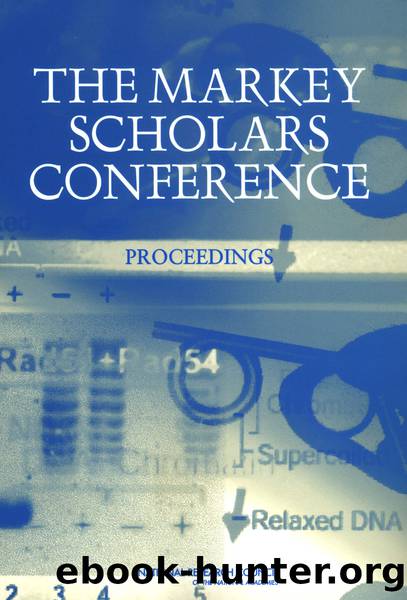THE MARKEY SCHOLARS CONFERENCE: PROCEEDINGS by National Research Council of the National Academies

Author:National Research Council of the National Academies
Language: eng
Format: epub
Tags: Policy for Science and Technology
Publisher: NATIONAL ACADEMY PRESS
Published: 2004-05-18T00:00:00+00:00
THE OMPR/PHOB FAMILY OF TRANSCRIPTION FACTORS
The chemotaxis system is a somewhat atypical two-component system. The two response regulators of the chemotaxis system are unusual in that they are not transcription factors. The vast majority of response regulators in two-component systems are responsible for regulation of gene expression and the effector domains of these response regulators are DNA-binding domains. The bacterial response regulators can be divided into subfamilies based on homology within their C-terminal DNA-binding domains.
A survey of the E. coli genome conducted by Mizuno several years ago, revealed that out of the 32 response regulators in E. coli, 25 of them could be categorized as belonging to the previously identified three subfamilies of transcription factors based on homology within their DNA-binding domains. One of these three families, the OmpR/PhoB family, accounts for approximately 40 percent of all response regulators in bacterial genomes. This subfamily is characterized by a DNA-binding domain with a winged-helix fold. The OmpR/PhoB group is by far the largest subfamily. There are two other smaller subfamilies of transcription factors with different types of DNA-binding domains. A small number of proteins are unrelated to other response regulators and are grouped into a miscellaneous category. The two chemotaxis proteins discussed above are members of this group.
We are interested in the large family of transcription factors represented by the OmpR/PhoB subfamily. The family is named after the OmpR protein that participates in osmoregulation in E. coli. The osmoregulation system involves a histidine kinase EnvZ that is a transmembrane kinase that senses changes in osmotic strength. EnvZ provides phosphoryl groups to the response regulator OmpR, which functions as a transcription factor. The C-terminal, or effector, domain of this response regulator is a DNA-binding domain, and OmpR, in its phosphorylated state, binds in a hierarchical fashion to binding sites that are located upstream of the genes that encode the major outer membrane porin proteins, OmpF and OmpC. These proteins are regulated not in a single on-off switch fashion, but in a much more subtle way. At low osmotic strength, there is a high level of expression of ompF. At high-osmotic strength, there is a high level of expression of ompC. Expression of these genes is differentially coordinated so that the total concentration of porin proteins remains constant while the composition varies.
The OmpR protein serves as both an activator and repressor of transcription, depending on the binding sites that are occupied. Each of the binding sites preceding the ompF and ompC genes consists of two ten-base pair half-sites arranged as direct repeats.
Structural analysis of the DNA-binding domain of OmpR by Erik MartÃnez-Hackert, a graduate student in my laboratory, defined the winged-helix fold for this family. Several experiments including site-specific cleavage analysis allowed us to predict a model for the interaction of this DNA-binding domain with its recognition sites in DNA. This model, though useful, is incomplete. In the cell, the phosphorylated regulatory domain is required for efficient DNA binding and transcriptional regulation. We would like to understand the specific role of the regulatory domain in allowing the DNA-binding domain to interact with its DNA sites.
Download
This site does not store any files on its server. We only index and link to content provided by other sites. Please contact the content providers to delete copyright contents if any and email us, we'll remove relevant links or contents immediately.
| Administration & Medicine Economics | Allied Health Professions |
| Basic Sciences | Dentistry |
| History | Medical Informatics |
| Medicine | Nursing |
| Pharmacology | Psychology |
| Research | Veterinary Medicine |
Periodization Training for Sports by Tudor Bompa(7946)
Why We Sleep: Unlocking the Power of Sleep and Dreams by Matthew Walker(6386)
Paper Towns by Green John(4826)
The Immortal Life of Henrietta Lacks by Rebecca Skloot(4274)
The Sports Rules Book by Human Kinetics(4097)
Dynamic Alignment Through Imagery by Eric Franklin(3935)
ACSM's Complete Guide to Fitness & Health by ACSM(3834)
Kaplan MCAT Organic Chemistry Review: Created for MCAT 2015 (Kaplan Test Prep) by Kaplan(3815)
Introduction to Kinesiology by Shirl J. Hoffman(3634)
Livewired by David Eagleman(3547)
The River of Consciousness by Oliver Sacks(3431)
The Death of the Heart by Elizabeth Bowen(3355)
Alchemy and Alchemists by C. J. S. Thompson(3312)
Descartes' Error by Antonio Damasio(3170)
Bad Pharma by Ben Goldacre(3118)
The Gene: An Intimate History by Siddhartha Mukherjee(2942)
The Emperor of All Maladies: A Biography of Cancer by Siddhartha Mukherjee(2942)
The Fate of Rome: Climate, Disease, and the End of an Empire (The Princeton History of the Ancient World) by Kyle Harper(2893)
Kaplan MCAT Behavioral Sciences Review: Created for MCAT 2015 (Kaplan Test Prep) by Kaplan(2832)
